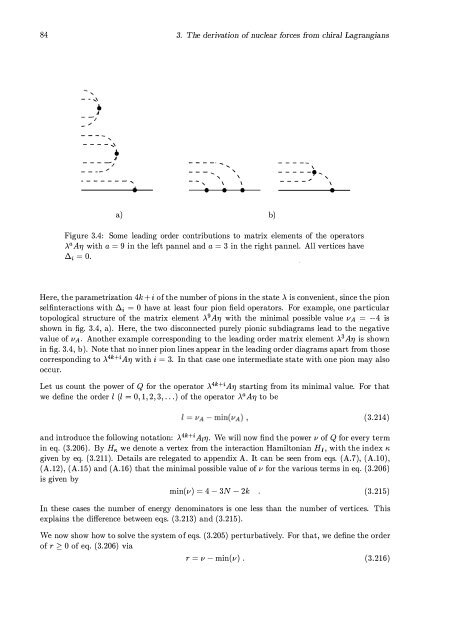The Nucleon-Nucleon Interaction in a Chiral Effective Field Theory
The Nucleon-Nucleon Interaction in a Chiral Effective Field Theory
The Nucleon-Nucleon Interaction in a Chiral Effective Field Theory
You also want an ePaper? Increase the reach of your titles
YUMPU automatically turns print PDFs into web optimized ePapers that Google loves.
84<br />
.... .<br />
- - .... \ .<br />
•<br />
A<br />
.... .<br />
. - - - - .... \<br />
•<br />
A<br />
.. _ - - - - - ,<br />
•<br />
a)<br />
3. <strong>The</strong> derivation of nuclear forces from chiral Lagrangians<br />
- - - _. - .... .<br />
.... .<br />
.... .<br />
\<br />
. .... \ \<br />
• • •<br />
b)<br />
\<br />
- -- - -, ...<br />
'"'<br />
.... .<br />
- - - - \<br />
•<br />
Figure 3.4: Some lead<strong>in</strong>g order contributions to matrix elements of the operators<br />
.x a A'T} with a = 9 <strong>in</strong> the left pannel and a = 3 <strong>in</strong> the right pannel. All vertices have<br />
ßi = o.<br />
Here, the parametrization 4k + i of the number of pions <strong>in</strong> the state .x is convenient, s<strong>in</strong>ce the pion<br />
self<strong>in</strong>teractions with ßi = 0 have at least four pion field operators. For example, one particular<br />
topological structure of the matrix element .x 9 A'T} with the m<strong>in</strong>imal possible value VA = -4 is<br />
shown <strong>in</strong> fig. 3.4, a). Here, the two disconnected purely pionic subdiagrams lead to the negative<br />
value of VA. Another example correspond<strong>in</strong>g to the lead<strong>in</strong>g order matrix element .x3 A'T} is shown<br />
<strong>in</strong> fig. 3.4, b). Note that no <strong>in</strong>ner pion l<strong>in</strong>es appear <strong>in</strong> the lead<strong>in</strong>g order diagrams apart from those<br />
correspond<strong>in</strong>g to .x 4k +i A'T} with i = 3. In that case one <strong>in</strong>termediate state with one pion may aiso<br />
occur.<br />
Let us count the power of Q for the operator .x4k +iA'T} start<strong>in</strong>g from its m<strong>in</strong>imal value. For that<br />
we def<strong>in</strong>e the order l (l = 0, 1,2,3, ... ) of the operator .xa A'T} to be<br />
(3.214)<br />
and <strong>in</strong>troduce the follow<strong>in</strong>g notation: .x4k + i A/'T}. We will now f<strong>in</strong>d the power v of Q for every term<br />
<strong>in</strong> eq. (3.206). By HK, we denote a vertex from the <strong>in</strong>teraction Hamiltonian HJ, with the <strong>in</strong>dex K,<br />
given by eq. (3.211). Details are relegated to appendix A. It can be seen from eqs. (A.7), (A.10),<br />
(A.12), (A.15) and (A.16) that the m<strong>in</strong>imal possible value of v for the various terms <strong>in</strong> eq. (3.206)<br />
is given by<br />
m<strong>in</strong>(v) = 4 - 3N - 2k (3.215)<br />
In these cases the number of energy denom<strong>in</strong>ators is one less than the number of vertices. This<br />
expla<strong>in</strong>s the difference between eqs. (3.213) and (3.215).<br />
We now show how to solve the system of eqs. (3.205) perturbatively. For that, we def<strong>in</strong>e the order<br />
of r :::: : 0 of eq. (3.206) via<br />
r = v - m<strong>in</strong>(v) . (3.216)












